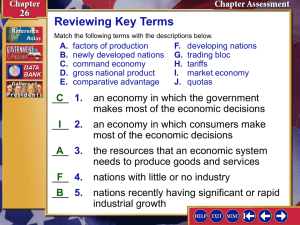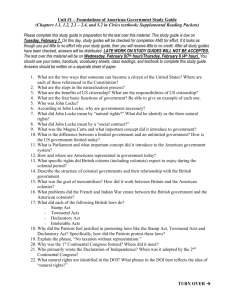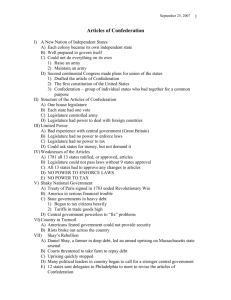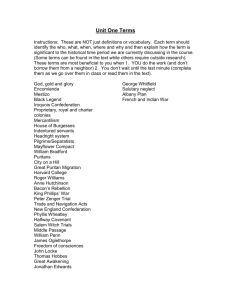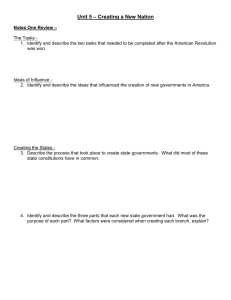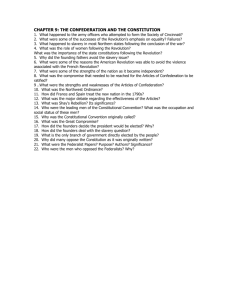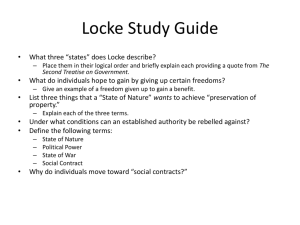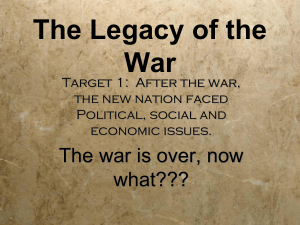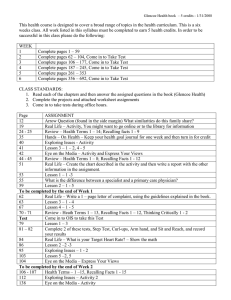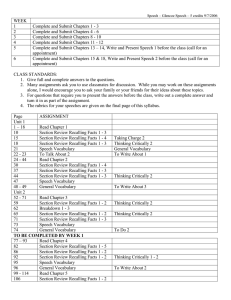Chapter 2 Review
advertisement
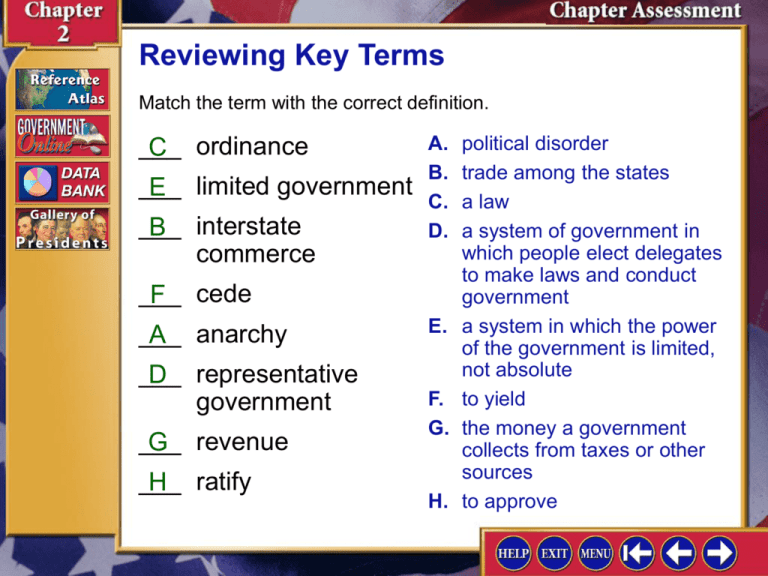
Reviewing Key Terms Match the term with the correct definition. ___ C ordinance ___ E limited government ___ B interstate commerce A. B. C. D. ___ F cede ___ A anarchy ___ D representative government ___ G revenue ___ H ratify E. F. G. H. political disorder trade among the states a law a system of government in which people elect delegates to make laws and conduct government a system in which the power of the government is limited, not absolute to yield the money a government collects from taxes or other sources to approve Recalling Facts 1. Identify three key ideas found in the English Bill of Rights. Any three: monarch must rule with consent of governed; monarch must have legislature’s consent to suspend laws, levy taxes, or maintain army; monarch may not interfere with legislative elections or debates; people have right to petition government and to fair and speedy trials by juries of peers; no cruel and unusual punishment or excessive fines or bails. Recalling Facts 2. According to John Locke, what fundamental element made government legitimate? According to John Locke, the consent of the people made government legitimate. 3. Describe the practices established by colonial governments that became a basic part of our system of government. Practices established by the colonial governments include separation of powers between governor and legislature, legislature of elected representatives, and a written constitution guaranteeing basic liberties and limiting power of government. Recalling Facts 4. What tasks did the Second Continental Congress accomplish? They acted as a central government, organized an army and navy, issued money to pay for a war, named George Washington as commander of army, purchased supplies, negotiated treaties with other countries, and rallied support for colonists’ cause. 5. Why was the Declaration of Independence a revolutionary document? It called for a country whose government was founded on principles of human liberty and consent of the governed, the world’s first such country. Recalling Facts 6. What achievements were made under the Articles of Confederation? The Articles of Confederation established fair policy for development of western lands; concluded peace treaty with Great Britain; established departments of Foreign Affairs, War, Marine, and Treasury; and provided that states recognize legal acts of other states and treat one another’s citizens without discrimination. Recalling Facts 7. State the position of small states in the debate over representation in Congress. Small states favored equal representation with large states. Large states wanted representation based on population. 8. What issue did the Convention delegates refuse to settle in 1787? They refused to settle the issue of slavery. Understanding Concepts 1. Growth of Democracy Analyze the impact of the English political heritage on the United States and its importance to the Declaration of Independence. Answers might include ideas expressed in the Magna Carta and English Bill of Rights, principles of limited government and representative government, and ideas of John Locke. Understanding Concepts 2. Federalism In your opinion, why were the Articles of Confederation an unworkable or unrealistic plan of government? The Articles of Confederation lacked power to enforce its own laws and lacked power over the states. Understanding Concepts 3. Civil Liberties Why did the Anti-Federalists insist on a Bill of Rights? They wanted to prevent government from violating individual rights. Critical Thinking 1. Understanding Cause and Effect Use a graphic organizer like the one below to analyze the cause for each effect listed. Causes: the states’ common goals, such as national protection; differences among the states. Critical Thinking 2. Synthesizing Information How do you account for the contradiction between the constitutional acceptance of slavery and the ideals set forth in both the Declaration of Independence and the Constitution? People who favored slavery did not consider slaves to be entitled to the same rights as whites. People who opposed slavery compromised their beliefs in order to establish a much-needed government. Interpreting Political Cartoons Activity 1. What symbol represents the colonies in this 1779 political cartoon? The bucking horse represents the colonies. Interpreting Political Cartoons Activity 2. Who do you think the rider on the horse is? The rider could be King George III or other British leaders. Interpreting Political Cartoons Activity 3. What is the message of this cartoon? America is breaking its relationship with Great Britain by getting rid of its master, King George III. The Liberty Bell in Independence Hall cracked during the funeral of which chief justice of the United States? John Marshall
